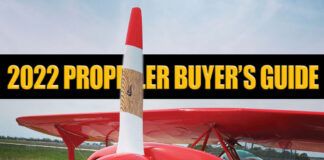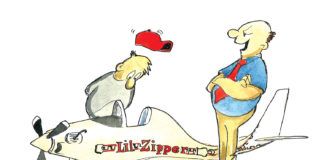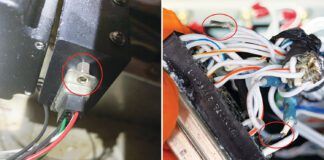What do you suppose is the minimum thrust it takes to keep one of these things in the air?”
I cant even remember who said it, but it started a chain of events that once again became a Dawn Patrol event to be remembered.
It had been a perfect Nieuport Day at Liberty Landing International Airport. The weather was severe clear. Temperatures were in the 70s. The winds had been perfect Nieuport winds too, right down the runway at 0, gusting to 2.
Mark Pierce, Tom Glaeser, Dick Lemons and I had put several hours on our little warbirds, patrolling the Missouri River bottoms around the airport. Our lethal death-dealing, wing-mounted Lewis 303 machine guns spit out fiery streams of lead, sending hundreds of marauding Fokker E-IIIs down in flames. Yessirreebob. No wandering cows had been victims of enemy fighters strafing the allied trenches. The Dawn Patrol was on the job, kicking butt and taking names!
Idle Minds
Later, we were sitting there in our lawn chairs at the hangar, guzzling some frosty cans of diet Dr. Pepper and watching Sharon (my sweetie) shoot touch-and-goes in her Kolb Twinstar. There in the shade, criticizing and grading her landings, counting the bounces. It doesn’t get any better than that.
Anyway, as it usually does, our conversations drifted from subject to subject like minnows aimlessly wandering around the shallows of a Missouri farm pond: flying, women, cars, brands of beer, women, movies, wives (certainly not to be confused with women), engines, props, quantum physics, women… we discussed them all.
Now and then a resounding, booming, dredged-up-from-the-depths, visceral belch resonated around the airport and vibrated the hangar walls, followed by sounds of envious approbation and applause. No one can say were not a classy, refined bunch. Then came the comment about the minimum power it would take to fly a Nieuport. That lit the fuse.
By this time, all of us in The Dawn Patrol were flying our Nieuports with direct-drive VWs. Mark and Dick had started with two-stroke engines in theirs, but changed to VWs after recognizing how much better the VWs sound and how trouble-free they are. I didn’t like the direction this discussion was taking.
Tom and I had already done some testing of different props on our planes, and the results were memorable. Wed tried one of Toms little toothpick KR-2 props on my plane, and while the increase in rpm was really good (from 3000 rpm static to 4000 static) the flight test was good. The service ceiling with that prop on my Nieuport was about 15 feet. Thank goodness the corn was only 5 feet tall then, or Id probably have totaled my plane. (I know, we should have pull-tested it, but we didn’t know then what we know now… which still aint a lot!)
Necessity Is the Mother of Invention
We needed a better and safer way to test things. Our Nieuports had been flying trouble-free now for several years. More and more builders were working on their own Nieuport projects and had been asking our opinions on what engines and props to use. We needed a better response than just standing there, scratching our rears, saying, “Boy, that sounds good to me.”
After a spirited discussion we finally settled on a safe way to test our idea. One of the guys at the airport is a devoted deer hunter, and he had a spring scale that went to 300 pounds. The first thing we needed to do was make sure the spring scale was accurate. Being The Dawn Patrol, we used empirical means to ascertain that the scale was close to being correct. We went up to Jerry Sharps house, right on the airport (lucky bum), and borrowed his bathroom scale. Then we each stood on the scale and wrote down the different weights. This was also a good time for some really tasteless jokes.
Jerry Sharp became world famous when, after an extended series of engine failures in the two-stroke engine in his Avid Flyer, he finally snapped one day, ripped the engine off the plane and threw it into the Missouri River from a bridge. People have driven to the airport just to meet him, shake his hand and tell him about their forced landings. (See KITPLANES, October 1997, “The Two-Cycle Engine Toss.”)
Unscientific Research
Anyway, back to the story. We wrote our weights on our pants legs because, as usual, we didn’t have any paper. Then we went back to the hangar, hung the spring scale from a rafter, rigged up a swing seat, and each of us sat in it and noted the weight on the scale. It was within 5 pounds for each of us, so we were satisfied. It was time for the real experiment.
We tied one end of the scale to a cars trailer ball and the other to a Nieuport. Wed found some sheets of plywood to rest the wheels on so that they would roll as easily as possible on the ground. We started the engine and ran it up to full throttle, noting the pull on the scale. We did this with each Nieuport several times and averaged the results. All the planes pulled 195 to 205 pounds.
Static thrust on a clean aircraft is sometimes not a good number to depend on, because the prop unloads in the air, quits cavitating, and becomes more efficient. But on a really dirty WW-I replica its a totally different ball of snakes.
Wed already noticed that we didn’t get much increase in rpm while in the air because, as Tom put it, “These planes are so dirty that even in the air they think they’re still on the ground.” Besides, our planes had been flying for years, so any numbers we got while testing had to be relevant (for 7/8scale Graham Lee Nieuport replicas only).
We decided we were going to run the engines up till we got pulls of 125 pounds, 150 pounds and 175 pounds. Wed record the rpm required from each of those tests to give the desired pull. Armed with that information, we would be ready to do some real testing. (This definitely wasn’t going to be rocket science.)
Calling All Volunteers
We had to decide who was going to be the test pilot. Someone remarked that the plane and pilot used for the test should be the heaviest. There was a loooong, strained silence. I just looked at the ground and waited. (I knew it was going to be me. At that time, I tipped the scales at 230 pounds of fighting flab and also had the heaviest plane at 435 pounds empty weight.) The silence dragged on. I finally looked up, and everyone was staring at me.
“What?” I said.
They all just looked at me and blinked. I knew I was doomed. Ah, well… this was for science and the advancement of aeronautical knowledge, a good cause. I kept telling myself that. We hooked my plane up to the deer scale and got ready to record some data. The Up-in-Smoke Aeronautical Data-Recording and Research Center was open for business.
Mounting The Gray Falcon, I cranked her up. She belched, blew smoke out of every orifice and settled down to a throaty rumble. I let her run for awhile to get the oil warmed up. Then, watching in the rear-view mirror, I opened the throttle as Tom, Mark and Dick Lemons gathered around the pull-tester. When it reached 125 pounds, they signaled me and I noted the rpm on a scrap of cardboard. We recorded the rpm needed for 150 and 175 pounds. Then we did it again several more times and averaged the results.
We unhooked her from the tester. I taxied out to the active (and only) runway at Liberty Landing. Holding the brake lever, I advanced the throttle and set it at the 125-pounds-of-pull rpm. Then, after locking my pucker-factor setting in, I released the brake and started down the 1800-foot runway. Winds were calm.
She started her takeoff roll slower than normal. After 500 feet, the tail slowly came up. (Usually were off the ground and climbing out after about a 250-foot roll.) At 1000 feet she was kinda skipping along on her mainwheels, but I could tell she didn’t want to fly. I firewalled the throttle, made a normal takeoff, went around the patch and landed.
Taxiing back to the runway, I did the same thing, only this time I set the throttle lever so the rpm reading was for 150 pounds of pull. I released the brake and away we went. The tail came up a lot sooner and she was skipping along pretty good by the 900-foot mark. At about 1500 feet, she finally came unstuck and we headed upstairs at a thrilling 10 fpm.
The test at 175 pounds of pull flew the plane. Not well, but she did lift and had a better, but not impressive, rate of climb. The experiment was over. Wed found out what we needed to know. You need at least 195 pounds of static thrust to happily fly one of our Nieuports.
Afterward
Since that day, 14 years ago, a lot has happened. The great flood of 93 totaled our planes, and they had to be rebuilt from the frame up. Engines had to be overhauled, and we all needed new props. Even worse, our spring pull-tester disappeared somewhere in the 2 feet of mud that was left on the airport after the water went down. We never did find it. (See KITPLANES, February/March 1994, “The Great Flood of 93, Parts 1 & 2.”)
We needed some new props and, as usual, drove down to see our prop gurus, Gene and Larry Smith of Culver Props in Rolla, Missouri. Gene told us about the different pulls his direct-drive VW props would put out at various rpm. We asked him how he did his testing, and he showed us a neat, compact little hydraulic pull-tester they had designed.
Gene gave us the pull-testers part numbers and where he got them. We quickly whipped up our own tester, and it works great. Its a small hydraulic cylinder with a regular PSI gauge that you just hook up between the airplane and a car/pole/whatever.
Naturally, we had to calibrate it to see if it was correct, so we weighed several different 50- and 100-pound bags of cement. It was within 3 pounds every time! Gene and Larrys hydraulic tester has been tested and compared with an expensive, digital, top-of-the-line, state-of-the-art pull-tester. We tied them together in series and pulled them to where they both read 600 pounds of pull. There was only a 2-pound difference in the readings.
Since then, we’ve pull-tested every plane on the field and quite a few that other pilots have flown in to compare props and engines. Like I said, this aint rocket science, just good old shade-tree mechanics. Knowing what you’ve got might save you a landing in the crops.
Now when we get those calls from other Nieuport builders asking, “Do you think it will fly?” we ask them some questions that will help us to give more informed answers.
Whats your aircraft empty weight?
Wheres your empty weight cg from the firewall?
Whats your weight?
Wheres your loaded cg from the firewall?
Do you have a pull-tester?
Then the big question: Whats your thrust at full throttle? If their answer is less than 200 pounds, we can offer a good guess of how their plane is going to fly… not well. If their answer is less than 175 pounds, we tell them to leave it in the hangar.
A disclaimer: Im sure some super-smart, college-trained, number-crunching, wind-tunnel-using, computer-abusing, real rocket-science-type aeronautical engineers are shuddering as they consider our research. Let me state right up front that we are not aeronautical engineers. Were not even engineers. Heck, were barely even aeronautical! But this works great for us. It fits our needs. Its simple. Its cheap. And it tells us what we need to know in a safe manner.
You can build your own tester using the information above, or buy one ready-made from Culver Propellers: http://www.culverprops.com/.
All parts, except my back-mounted pressure gauge, came from Surplus Center at http://www.surpluscenter.com/




